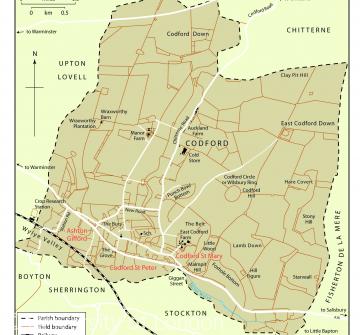The Parish
 A map of the civil parish of Codford, Wiltshire
A map of the civil parish of Codford, WiltshireParishes are found across much of western Europe. The majority of England’s medieval parishes were established by 1200 sometimes, but by no means always, sharing boundaries with a manor. By the post-Conquest period the whole country had been divided into parishes. In Midland and southern England these were relatively small, reflecting population pressure, but in the more sparsely populated north, parishes could be vast. Over time, as a result, in northern England the unit of local government became the township.
This combined role lasted until the nineteenth century when central government began to relieve the ecclesiastical parish of its civil powers. After 1834 the administration of poor relief was moved to the newly created unions with their Boards of Guardians, and roads became a county commitment. In 1888 the government abolished the old quarter sessions in favour of elected county councils, and in 1894 set up rural districts, which were responsible for administering larger areas. Meantime, during the Victorian period, some 3,000 new parishes were established, mainly in towns, all of which were granted ecclesiastical but not civil powers. Then modern division is between locally elected parish councils which exercise some civil powers, and Parochial Church Councils which, with the churchwardens, continue to run the church.









